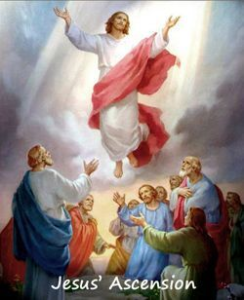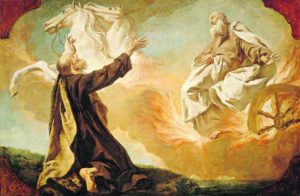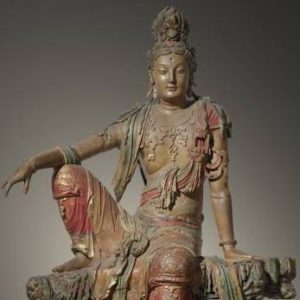Today is Ascension Day, 2020, in the Christian Tradition. When Cathy showed me the schedule of services at
Living Interfaith Sanctuary this spring, I knew this was my time to speak. The following is the first part of my message at the LISanctuary service last Saturday.
Christianity
Ascension is what my life is about these days, but let’s start with honouring the Christian tradition. Ascension Day, or the day Jesus ascended into the heavens, is celebrated on the 40th day after Easter. Along with Christmas, Easter and Pentecost, Ascension day is one of the main Christian Holy Days.

Image Courtesy of daily-prayers.org
Jesus had lived his life, been crucified in Jerusalem, resurrected on Easter and then he began showing himself to various people and groups during those 40 days. Imagine being one of the disciples. Your leader, your teacher, your friend had just willingly gone to his death, then showed up again! He tells you to spread this story, the gospel, to all the nations of the world and then tells you to go back to Jerusalem and wait for the coming of the Holy Spirit. He gives you a blessing and then steps away only to be lifted up into a cloud and disappear.
I would certainly be confused…and also sad and maybe a bit angry or scared. But, no… we are told the disciples were in joy. Stunned, yes, but in joy because they knew that when Jesus ascended, all the promises regarding His ministry to the disciples were about to be fulfilled.
The disciples accepted His ascension, for they had accepted Jesus’ word about the promised One to come, the Holy Spirit. Their doubts and fears were gone. They were convinced of who He was. They knew that He died to forgive them of their sins. They knew He was alive from the dead. In His resurrection, they had hope in victory over death, and knew they would be joining him in heaven with God the Father. Jesus was not leaving but shifting from a physical to a spiritual relationship. He was to be their Intercessor at the right hand of the Father, giving them hope and comfort and companionship.
This is the heart of the Christian tradition and Jesus’ ascension is the final piece of his work here on earth.
The concept of Ascension
Ascension has been around for a very long time. It is defined as a ‘raising up of a person above the heavens’ (without dying). Some suggest the most ancient definition is that which was used to describe the elevation of a visionary so that one is able to contemplate the heavenly world normally hidden from one’s eyes. In ancient Greek mythology it was known as entering the realm of the god(s). For instance, Hercules is said to have ascended. And then, as I was learning about and experiencing other faiths at the Vancouver School of Theology, I realized that other Abrahamic religions also had the concept of ascension as part of their tradition. Similarly, Ascension in these traditions refers to the translation or taking up to heaven of a few chosen ones, either to remain there in lieu of dying, or merely to receive revelations and then to return to earth.
Judaism
In Judaism, Ascension as a ‘taking up’ or the granting of a vision is associated with Patriarchs such as Enoch and Prophets such as Elijah. Jewish Rabbinical literature suggests that there were others, but Enoch and Elijah are the most often noted.
From the Hebrew scriptures we read that, during a life span of 365 years “Enoch walked faithfully with God; then he was no more, because God took him away.” Genesis 2 v.24 (NIV) In II Kings 2 v.11-12 (NIV), we read that Elijah was walking with Elisha along the Jordan River:

Image Courtesy of Jewish News
“As they were walking along and talking together, suddenly a chariot of fire and horses of fire appeared and separated the two of them, and Elijah went up to heaven in a whirlwind. 12 Elisha saw this and cried out, “My father! My father! The chariots and horsemen of Israel!” And Elisha saw him no more.”
The Jewish tradition of the Elijah Cup celebrates this. A door is opened and a cup of wine is set on the table at the celebration of the Seder on Passover and reserved for the precursor of the Messiah, the prophet Elijah, who according to Jewish tradition may come anytime as a guest. Perhaps you noticed this during our Sanctuary Seder service last month.
Islam
The prophet Muhammad, in the Islamic tradition, is said to have ascended around the year 621 CE, specifically to receive revelations and then to return to earth in what is

Image Courtesy of khalifatworld.com
referred to as The Night Journey or Miraj. This is referenced briefly in the Quran and expanded upon in the Hadith.
The festival is celebrated by telling the story of how the Prophet Muhammad was visited by two archangels while he was asleep, who purified his heart and filled him with knowledge and faith. The Prophet, in this visitation, travelled from Mecca to Jerusalem in a single night on a strange winged creature called Buraq. From Jerusalem he ascended into heaven, where he met the earlier prophets, and eventually God. During his time in heaven Muhammad was told of the duty of Muslims to recite Salat (ritual prayer) five times a day. (Islamic tradition avoids the images of any living creature.)
A Brief Historical Perspective
An ascension narrative is present in each of these faith traditions. To give you some historical perspective, Judaism’s beginnings were in the 7th century BCE; Christianity’s in the 1st century CE and Islam’s in the 7th century CE.
As we focus on the earliest wisdom teachings, the essence of each faith, all Abrahamic traditions find at their core the same ethics and values: that of love, peace, compassion and service to others. Indeed, when specific language, doctrine and rituals are set aside, the foundation of most religions come from the same source: Yahweh, God, Allah. This is also the heart of Interfaith.
Of course, ascension narratives are also present if not a central tenet in Gnosticism as well as many of the Eastern faith traditions. To go there would mean those at the service on Saturday would have a very late lunch. It would also make this post’s length unwieldy. Just know that it is present everywhere.
That was then, and this is now…
For me, today, ascension is all about home. I’ll share that final piece of my message in the next post, Ascension: Then and Now (Part II).

Quan Yin – Bodhisattva/Goddess of Compassion
by Eloecea
Header image courtesy of NASA/ESA Hubble Space Telescope
 Familiar refers to the times when your mind recognizes certain situations or people. You’ve been with them or in that situation before.
Familiar refers to the times when your mind recognizes certain situations or people. You’ve been with them or in that situation before. become aware of who we are. We can release the old emotions that come up when we consider making a change, finding new insights and integrating the new into our life. We can choose to change the channel we are watching, to shift our focus from what was to what is now possible. Seeds of freedom and expansion have been planted. Quiet moments of reflection unveil new ways of being in relationship, of creating income, new ways of living in love, joy, peace and harmony with all of creation. Let your love flow with the smallest of dreams… The world around us will reflect the changes happening within.
become aware of who we are. We can release the old emotions that come up when we consider making a change, finding new insights and integrating the new into our life. We can choose to change the channel we are watching, to shift our focus from what was to what is now possible. Seeds of freedom and expansion have been planted. Quiet moments of reflection unveil new ways of being in relationship, of creating income, new ways of living in love, joy, peace and harmony with all of creation. Let your love flow with the smallest of dreams… The world around us will reflect the changes happening within.



